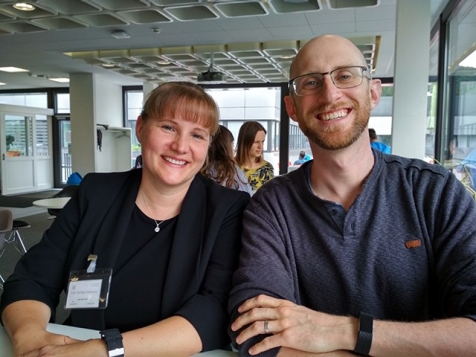Dissecting NGLY1 deficiency – An interview with Ulla Gerling-Driessen & Will Mueller

Project – Dissecting NGLY1 Deficiency
The Grace Science Foundation (GSF) was established to find, recruit, and fund a diverse team of researches across the globe to study a condition known as N -Glycanase 1 (NGLY1) deficiency. This is a rare disease that currently affects 47 patients worldwide. GSF has recruited five groups from EMBL and Stanford to be part of the worldwide team of researchers studying NGLY1 deficiency with expertise in various aspects of biology. Scientists from the Steinmetz Group at EMBL and the Bertozzi Group at Stanford are part of the research team. We caught up with two postdocs, Will Mueller (EMBL) and Ulla Gerling-Driessen (Stanford), to learn about the NGLY1 project, get their tips on effective collaboration, and what lessons they’ll take with them in the next phase of their careers.
Tell us about the project that you’re both working on.
Will: NGLY1 deficiency is caused by mutations in the NGLY1 gene that result in a loss of function. Although the function of the gene was known, it wasn’t clear how mutations in this gene could cause disease. Our lab was involved in multiomic profiling to look at cell-wide changes in the gene-to-protein pipeline and see what happens when you lose NGLY1. The Bertozzi Group looked into some of the hits we found, and identified one of the targets of NGLY1.
Ulla: We were able to link the activity of NGLY1 to the transcription factor Nrf1. It turns out that NRF1 is activated via a very unconventional pathway – the ERAD pathway – in which NGLY1 is a key player. The main function of Nrf1 is maintenance of the proteasome, which is particularly important under conditions of cellular stress.
The functions of Nrf1 are very diverse: it’s involved in the cell’s antioxidant response, in proteasome function, embryonic development and particularly neuron development. By establishing this causal relationship, we were able to explain some of the diverse symptoms of NGLY1 deficiency, which until then were not well understood.
It’s been an incredibly wonderful thing to say, “This is cool, but I don’t know what it means. I could Google it, or I could send an email to this team of people and get some wonderful suggestions and responses.”
How has this project benefitted from a collaborative approach?
Ulla: It’s important to say that it was not just us and EMBL. There’s a team and a lot of people involved who all have the same aim of finding a treatment and understanding the disease. They all look at it from a different angle and from that we can we can build an overall understanding of the disease.
Will: The expertise of Ulla and the Bertozzi Group allowed us to work together to draw better conclusions from our data. Without Ulla’s work, the relevance and context of the gene profile we saw wouldn’t have made much sense. Now the Bertozzi Group is following up on Nrf1 as a potential therapeutic target, not only for NGLY1 deficiency but also for other diseases.
How do you think you have personally benefitted from this project?
Will: The contacts that we’ve made are great and have made my work easier. It’s been an incredibly wonderful thing to say, “This is cool, but I don’t know what it means. I could Google it, or I could send an email to this team of people and get some wonderful suggestions and responses.” So it’s the realest ‘two minds are better than one’ experience that I’ve ever had.
Ulla: I met a great person! (She means Will). It’s also given me an introduction to EMBL, which is somewhere I would be excited about carrying on my research in the future. I think the collaborative environment at EMBL reflects the benefits that we also experience with the NGLY1 project.
“Nobody can be an expert in everything. Combining expertise in different areas is the best way to answer a big question or work on a challenging project.”
The Life Science Alliance offers joint postdoc positions between EMBL and Stanford. Why should other researchers consider taking on a collaborative project?
Will: Because you never know where it’s going to lead or what possibilities the other person’s expertise will open up – either for the project or yourself.
Ulla: Nobody can be an expert in everything. Combining expertise in different areas is the best way to answer a big question or work on a challenging project.
Read more about research in the Steinmetz Group at EMBL or the Bertozzi Group at Stanford.